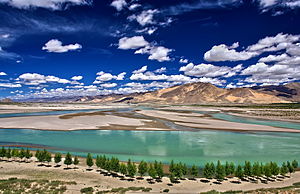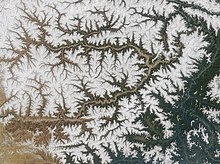| Yarlung Tsangpo yar klung gtsang po ཡར་ཀླུང་གཙང་པོ། 雅鲁藏布江 | |
|---|---|
 Yarlung Tsangpo, Shigatse Prefecture | |
 | |
| Location | |
| Country | China, India |
| Physical characteristics | |
| Source | |
| • location | Angsi Glacier in Shigatse, Tibet Autonomous Region, China |
| • coordinates | 30°23′N 82°0′E / 30.383°N 82.000°E |
| • elevation | 5,210 m (17,090 ft) |
| Mouth | |
• coordinates | 29°7′40.8036″N 95°1′19.8264″E / 29.128001000°N 95.022174000°E |
• elevation | 535 m (1,755 ft) |
| Length | 1,125 km (699 mi)[1] |
| Basin size | 241,691 km2 (93,317 sq mi)[2] |
| Discharge | |
| • average | 2,898.9 m3/s (102,370 cu ft/s)[2] |
| Basin features | |
| Tributaries | |
| • left | Raka Tsangpo, Nimu Maqu, Lhasa, Nyang |
The Yarlung Tsangpo, also called Yarlung Zangbo (Tibetan: ཡར་ཀླུངས་གཙང་པོ་, Wylie: yar kLungs gTsang po, ZYPY: Yarlung Zangbo) and Yalu Zangbu River (Chinese: 雅鲁藏布江; pinyin: Yǎlǔzàngbù Jiāng) is a river that flows through the Tibet Autonomous Region of China and Arunachal Pradesh of India. It is the longest river of Tibet and the fifth longest in China.[3] The upper section is also called Dangque Zangbu meaning "Horse River".[4][5]
Originating at Angsi Glacier in western Tibet, southeast of Mount Kailash and Lake Manasarovar, it later forms the South Tibet Valley and Yarlung Tsangpo Grand Canyon before passing into the state of India's Arunachal Pradesh. Downstream from Arunachal Pradesh, the river becomes far wider and is called the Siang. After reaching Assam, the river is known as the Brahmaputra.
When leaving the Tibetan Plateau, the river forms the world's largest and deepest canyon, Yarlung Tsangpo Grand Canyon.[6]
Description
[edit]



The Yarlung Tsangpo River is the highest major river in the world. Its longest tributary is the Nyang River. Major tributaries of Yarlung Tsangpo include Nyangchu River, Lhasa River, Nyang River, and Parlung Tsangpo.
In Tibet the river flows through the South Tibet Valley, which is approximately 1,200 kilometres (750 mi) long and 300 kilometres (190 mi) wide. The valley descends from 4,500 metres (14,800 ft) above sea level to 3,000 metres (9,800 ft).[7][8] As it descends, the surrounding vegetation changes from cold desert to arid steppe to deciduous scrub vegetation. It ultimately changes into conifer and rhododendron forest. The tree line is approximately at 3,200 metres (10,500 ft).[9] Sedimentary sandstone rocks found near the Tibetan capital of Lhasa contain grains of magnetic minerals that record the Earth's alternating magnetic field current.[10]
The basin of the Yarlung River, bounded by the Himalayas in the south and Kang Rinpoche and Nyenchen Tanglha Mountains in the north, has less severe climate than the adjacent northern (and higher-altitude) parts of Tibet, and is home to most of the population of the Tibetan Autonomous Region.
The Yarlung Tsangpo Grand Canyon, formed by a horse-shoe bend in the river where it leaves the Tibetan Plateau and flows around Namcha Barwa, is the deepest, and possibly longest canyon in the world.[11]
The Yarlung Tsangpo River has three major waterfalls in its course.[12] The largest waterfall of the river, the "Hidden Falls", was not publicized in the West until 1998, when its sighting by Westerners was briefly hailed as a "discovery".[13] They were even portrayed as the discovery of the great falls which had been the topic of stories told to early westerners by Tibetan hunters and Buddhist monks, but which had never been found by Western explorers at the time.[14] The Chinese authorities contradicted, however, saying that Chinese geographers, who explored the gorge from 1973 on, had already taken pictures of the falls in 1987 from a helicopter.[15][16]
Kayak exploration
[edit]
Since the 1990s the Yarlung Tsangpo River has been the destination of a number of teams that engage in exploration and whitewater kayaking.[17] The river has been called the "Everest of Rivers" because of the extreme conditions of the river.[18] The first attempt to run was made in 1993 by a Japanese group who lost one member on the river.
In October 1998, a kayaking expedition sponsored by the National Geographic Society attempted to navigate the Yarlung Tsangpo Grand Canyon. Troubled by unanticipated high water levels, the expedition ended in tragedy with the death of expert kayaker Doug Gordon.[19]
In January–February 2002, an international group consisting of Scott Lindgren, Steve Fisher, Mike Abbott, Allan Ellard, Dustin Knapp, and Johnnie and Willie Kern, completed the first descent of the upper Tsangpo gorge section.[20]
Dams and hydropower projects
[edit]In November 2020, the chairman of PowerChina announced the construction of a "super" dam on the Yarlung Zangbo which would be the world's largest hydroelectric project.[21]
In December 2024, China has approved the construction of the Medog Hydropower Station, intended to be the world's largest hydropower dam on the Yarlung Zangbo, the project would cost about 1 trillion yuan ($127bn; £109.3bn)[22].
References
[edit]- ^ "YARLUNG TSANGPO (BRAHMAPUTRA RIVER) IN TIBET".
- ^ a b "Upper Brahmaputra".
- ^ Yue-man Yeung; Jianfa Shen (2004). Developing China's West: A Critical Path to Balanced National Development. Chinese University Press. p. 553. ISBN 978-9-62-996157-2.
- ^ Henry Strachey (1854). Physical Geography of Western Tibet, Part 24. W. Clowes. pp. 7–. OCLC 1063495284.
The river that carries the drainage of Nari-Mangyul and Utsang to the south-eastward is called by the Tibetans the rTachok Tsangspo, i.e. Horse River. The best of my Ladak informants could not assure me positively of its course below Lhasa, but assented fully to its identification with the main trunk of the Brahmaputra river, as asserted (and all but established) by the geographers of Bengal.
- ^ SHANTI (2016). "Brahmaputra River". University of Virginia. Retrieved 20 February 2022.
- ^ "The New largest Canyon in the world - The Great Canyon of Yalung Tsangpu River (Tibet)". www.100gogo.com. Archived from the original on 28 February 2008. Retrieved 19 July 2009.
- ^ Yang Qinye & Zheng Du (2004). Tibetan Geography. China Intercontinental Press. pp. 30–31. ISBN 7508506650.
- ^ Zheng Du; Zhang Qingsong; Wu Shaohong (2000). Mountain Geoecology and Sustainable Development of the Tibetan Plateau. Kluwer. p. 312. ISBN 0-7923-6688-3.
- ^ "Yarlung Tsangpo arid steppe". Terrestrial Ecoregions. World Wildlife Fund. Retrieved 29 June 2007.
- ^ "Yarlung Tsangpo River in China". Atmospheric Data Science Center. Archived from the original on 11 June 2002. Retrieved 27 June 2007.
- ^ "The World's Biggest Canyon". www.china.org. Retrieved 29 June 2007.
- ^ "Hidden Falls". WWD - Waterfall Database. Archived from the original on 27 October 2018. Retrieved 30 June 2007.
- ^ "Fabled Tibetan Waterfalls Finally Discovered". Archived from the original on 27 September 2007. Retrieved 7 July 2007.
- ^ Compiled by Nima Dorjee (7 January 1999). Fabled Tibetan Waterfalls Finally Discovered. World Tibet Network News. Published by The Canada Tibet Committee. Issue ID: 99/01/07 Archived 2007-09-27 at the Wayback Machine (retrieved on 14 September 2008)
- ^ Peter Heller (July 2002). Liquid Thunder. Outside Online. (retrieved on 14 September 2008)
Antonio Perezgrueso (undated). The Echo of Liquid Thunder. (span. original: Los ecos del trueno líquido) Explorations and Expeditions on the English pages of the Sociedad Geográfica Española (retrieved on 14 September 2008) - ^
Patrick Boylan (2 November 2001). "Controversy Surrounded Hidden Falls". www.louisville.edu. Archived from the original on 3 May 2005. Quoted without further information on "Shangri-La Found – Who found it first?". The Search for Shambhala. Retrieved 14 September 2008.
Little attention was paid to the Chinese team that had been striking for the falls during that fateful trekking season. They claimed to have reached the falls before Baker but were ignored for the most part by everybody except their government who decided to close the gorge to westerners.
- ^ "1994, 1995 & 1997 Tibet Expeditions". Tibet Hidden Falls. Archived from the original on 16 March 2017. Retrieved 16 March 2017.
- ^ Press release of successful kayak run
- ^ Walker, Wickliffe W. (September 2000). Courting the Diamond Sow: A Whitewater Expedition on Tibet's Forbidden River. National Geographic. ISBN 978-0-7922-7960-0.
- ^ Heller, Peter. "Tsangpo Expedition: Liquid Thunder". Outside Magazine. Outside Online. Retrieved 7 February 2009.
- ^ Patranobis, Sutirtho (29 November 2020). Janardhanan, Vinod (ed.). "China to build a super dam on its part of Brahmaputra river". Hindustan Times. Retrieved 11 December 2020.
- ^ https://www.bbc.com/news/articles/crmn127kmr4o
External links
[edit]- River from Heaven Documentary film by CNTV (Chinese)
